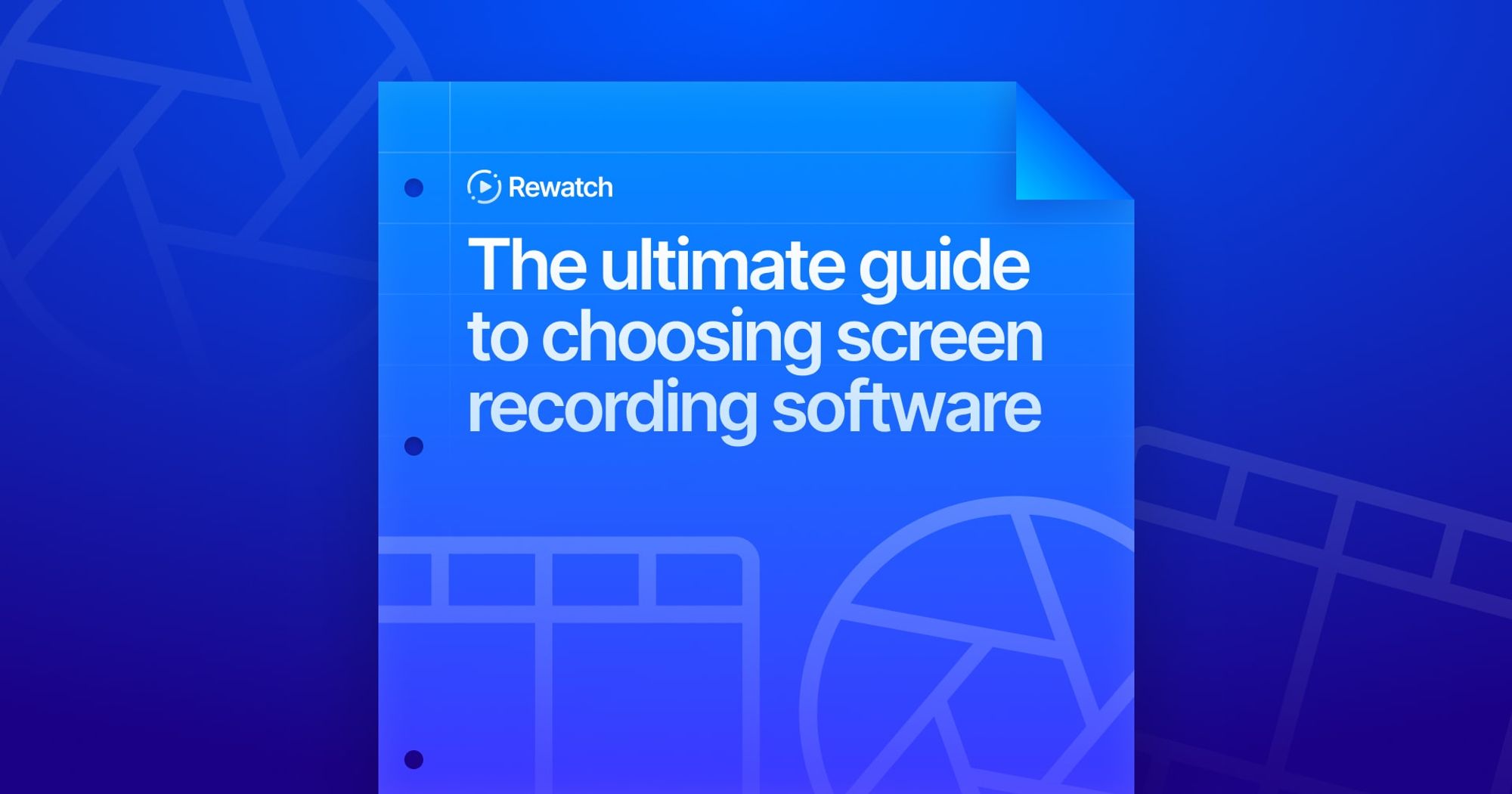How marketers should use screen recorders
Dive into the versatile application of screen recorders for marketers with 40 innovative ways these tools can be utilized.
By Liz Childers in

One of the most significant pain points Marketing teams face is that there are so many competing priorities. Marketers are charged with effectively connecting with audiences, managing and tracking campaign performance, managing internal workflows, efficiently creating and managing content, and doing constant market research and competitor analysis. These tasks can be both time-consuming and complex.
Our Marketing team’s motto is “small, but mighty.” It’s not uncommon to shock partners or Rewatch customers on calls when we share that there’s only four people on the team. We get a lot done, and it’s truthfully because we have bought into our own product.
Often underutilized in the marketer’s toolkit, Rewatch’s screen recorder offers a versatile solution to many of these challenges. It not only saves time but also enhances the quality and effectiveness of our marketing efforts, making it an invaluable resource. Because our screen recorder seamlessly works within the Rewatch ecosystem, videos are then searchable, sharable, and transcribed without any extra effort — plus our four-person team can collaborate on the videos and invite the rest of the company to join the conversation, when necessary.
Below are our favorite ways to use what we consider the best screen recorder on the market.
Content creation and management:
- Tutorial creation: Record step-by-step guides for using your product or service, useful for customer education. You can also record guides for tools that the team uses, speeding up new hire training.
- Product demos: Showcase product features and functionalities in action, which can be shared with potential customers.
- Webinar recording: Record on-demand webinars, creating a valuable repository for future campaigns and easy content repurposing.
- Podcast production: Record, edit, and publish podcasts.
- Online presentations: Create video content featuring your team discussing how they utilize your product, how they tackle pain points in their field, and more.
- Content Repurposing: Convert webinar recordings, podcasts, and online presentations into different content format by easily clipping the original recordings — and using the original transcript and AI-generated chapters to pinpoint key moments.
- Social media content creation: Generate unique content by recording interesting screen interactions or GIFs — and sharing the other repurposed content.
- Video marketing strategies: Document the planning and execution of video marketing campaigns, from storyboard to final edit.
Customer engagement & support:
- Customer testimonials: Invite customers to record feedback and testimonials to use in marketing materials.
- UX/UI feedback: Record user interactions with a website or app to get insights into user experience and interface issues.
- Customer support training: Create videos showing common customer problems and how to solve them.
- Customer journey mapping: Record the various stages of the customer journey on the website or app to analyze and improve the user experience.
- Online reputation management: Monitor and record online reviews and feedback for analysis and response planning.
- Referral program management: Create guides or demonstrations for customers or partners on how to use referral programs.
Market research & competitor analysis:
- Competitor analysis: Record and analyze competitor websites and their user experience for market research.
- Market research presentations: Record presentations on market research findings for internal education.
- Hashtag research: Record sessions of researching and selecting hashtags for social media campaigns.
- User persona development: Compile and record research data to create detailed user personas.
Collaboration and internal communication:
- Collaboration and team updates: Record async feedback and updates for team members, making the info easy to reference when it works for each person, unlike a regular meeting.
- Project management and planning: Record planning sessions to track project progress and decisions made.
- Feedback on creative work: Record constructive feedback on marketing materials like videos, graphics, or website design for creative teams.
- Email design process: Document the creative process of designing and coding email templates for team training or future reference.
Sales & marketing strategy
- Training videos for sales teams: Create detailed training materials for Sales teams about products, market trends, or Sales techniques.
- Influencer outreach: Document the process of identifying and reaching out to influencers for collaborations.
- Influencer partnership reviews: Document and review the progress and impact of influencer partnerships.
- Affiliate marketing management: Create tutorials or presentations for potential affiliates, showcasing how to promote products or use the affiliate platform.
- Sales funnel analysis: Visualize and analyze the stages of the sales funnel.
- Press release distribution: Record the strategy and process of distributing press releases.
Compliance and crisis management
- Crisis management: Document how various crises are handled for future training and preparedness.
- Legal compliance: Record and archive marketing activities for compliance with industry regulations.
- Localization of marketing material: Show how marketing materials should be adapted for different regions or languages.
- Marketing automation set-up: Record the setup processes of marketing automation tools for training purposes.
- Brand monitoring: Record instances of brand mentions or coverage across various platforms.
Campaign management & analysis
- Ad campaign reviews: Record and review the performance of digital ad campaigns, noting areas for improvement.
- SEO and analytics: Record sessions of SEO tools or analytics dashboards to analyze and share insights with the team.
- Email campaign strategies: Record and analyze the process of creating and sending email campaigns, noting what works best.
- A/B testing analysis: Record the process of setting up and reviewing A/B tests on websites or in email campaigns to analyze the effectiveness of different strategies.
- Search engine marketing strategies: Record strategies and analyses for PPC campaigns and other search engine marketing initiatives.
Ready to try the best free screen recorder? Rewatch’s is available for free. Try it today.
Insights for the modern workplace
Get fresh ideas and practical tips to help your team work better, together. Delivered straight to your inbox.

